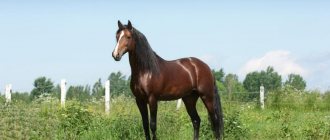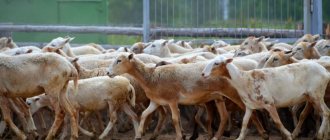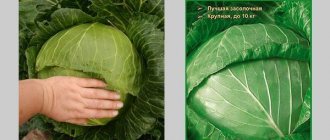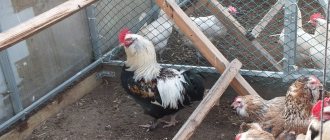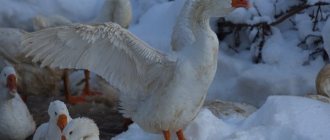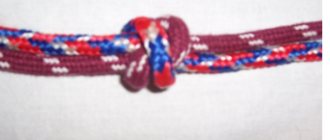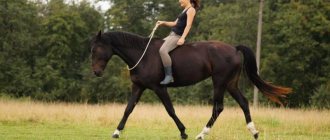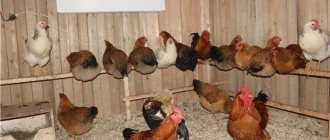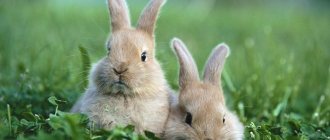Individual approach
Each horse requires an individual approach.
For example, some are afraid of “tickling” (those with thin skin), so you should not use a hard brush in particularly sensitive areas. You should not push in cases where the horse shows dissatisfaction or does not want to allow a person to clean in certain places. It is necessary to make the animal understand by stroking and talking that there is no danger or harm to health. It is better to walk around the horse from behind, and so that it is not afraid of a sharp touch, keep your hand on the animal at all times. To clean your hooves and comb your tail, you need to move slightly to the side, but at the same time stay as close to the horse as possible. In this case, you cannot stand behind the horse. In this position the horse will not be able to kick hard. Cleaning involves several “circles”. Therefore, when walking around a horse with another device, you should constantly keep your hand on the animal.
The main thing you need to know about horses is that care should not be a painful or unpleasant procedure for you or your pet.
Horse coat care
You need to start cleaning the horse from the head, working from the left side. Then, walking around the pet, go to the right side.
To clean wool you will need:
- Rubber and metal scrapers.
- Brush with hard and soft bristles.
- 2 sponges.
- Cloth in the shape of a mitten.
- The horse is wiped with cloth at the very end, thus adding shine to the coat and also collecting dandruff and dust that the brushes could not remove.
If you wipe the horse with a damp cloth after the coat has been brushed with a comb, this will make brushing much easier.
Instead of a cloth, you can also use a towel made from natural materials, for example, a linen rag.
It is better to buy brushes and squeegees on a belt: they fit well in the hand and are comfortable to use. As for the material, preference should be given to a rubber or leather base, since a wooden or plastic one can accidentally hit the animal painfully during cleaning.
Hoof care
Hooves are cleaned before or after basic grooming, there is no fundamental difference. Some people believe that starting with the hooves will make it easier to notice if the horse is lame. Particular attention should be paid to this part after walking on small gravel, stones, sand, which often gets stuck and causes inconvenience.
To care for your horse's hooves you will need:
- hook;
- brushes.
They begin to clean the hooves from the heel, moving along the edge of the front wall. Even though the end of the hook is blunt, it should not be used to clean off dirt in the V-shaped area (arrow). This is a very sensitive part that is brushed with extreme care. If you don't care for your hooves properly, they can become inflamed and even deformed.
For the outside of the hoof, you can use a coarser baleen brush. The same brush should be used to remove dried dirt from the bedding from the legs and rump. When the air temperature is not lower than 0, you can wash your hooves with foamy water and then wipe them dry.
In summer, other “cosmetic” procedures are also possible. For example, if the outer part (horn) begins to dry out and crack, you can wrap the hooves with damp rags, or even better, keep the horse in a stall with clay diluted with water on the floor for several days. After the procedure, it is necessary to lubricate the horn with Vaseline so that the moisture does not evaporate for as long as possible.
From time to time the horn should be filed, giving the hooves the correct beautiful shape.
Structure and description of the horse's body
Listening to the conversation of horse lovers, it is easy to notice that they use words that are not entirely clear. The height of an animal is usually referred to as “height at the withers”, and the parts of the horse’s body are called studs. There are basic characteristics that horse breeders use when describing a horse.
The external anatomical structure of a horse consists of examining the body of the animal and its individual parts. The conditional division is as follows:
Most often, it is in this order that articles of different breeds of horses are described. At the same time, pay attention to the shape, location, development of muscles and individual marks on the skin (spots, scorch marks, changes in hair color, etc.).
Head and neck
In the cervical region, clearly visible parts are the jugular groove (1 on each side of the neck) and the crest with mane. When describing such a feature as a neck, they talk about its length and power. Mane refers to long strands of hair that grow in a narrow stripe on the upper edge of the neck - the ridge. The ridge starts from the back of the head and ends at the base of the neck, where it meets the withers.
Horse hoof anatomy (video)
What does the torso consist of?
The body consists of several sections: the withers, shoulders and chest in front, the belly and sides from below in the middle part, and the back, lower back, rump and croup - above and behind. A horse's withers are called being above the shoulder blades. The powerful muscles that are concentrated in this section are outwardly visible, like a convex relief, if you look at the horse in profile. The height of the animal is measured precisely by the projection of the highest point of the withers above the ground, although the head is located much higher.
The shoulders are the lateral sections of the muscles between the withers and chest. The latter refers to the part of the body that is located below the neck in front and passes between the front legs. Speaking about the depth of the chest, we mean a decrease in its line in this part. Next is the stomach and sides. These sections cover all the lower and lateral sections of the body.
Read also: How to accustom a rabbit to nipple drinkers
The hindquarters of the horse are a separate piece. Above the sides, it is customary to distinguish maklaki: the projection of the hip bones. The back is considered to be the section located in front of them, starting from the withers and along the entire upper part of the body. Above the rumps is the loin, and behind them is the area called the horse's croup.
This section includes highly developed muscles on the sacrum and thighs. At the junction of the croup and flanks there are the inguinal regions of the body, which below pass into the udder (in mares) or prepuce (in stallions). When looking at a horse from behind, you can notice such features as the roundness and width of the croup. From the side, the degree of its drooping is noticeable - a view of the upper part.
Tail and legs
The horse's tail is also considered as a separate part and when describing it they talk about its length, meaning the distance from the beginning at the very croup to the ends of the long horsehair. But the horse's tail is also divided into several parts.
The repicule is the area where it extends from the body. This is a projection of the first caudal vertebra. If you imagine a horse without a tail, consisting of hair, you will find its base made of vertebrae with muscles, covered with skin, like other animals. Thanks to this structure of the tail, the horse can make various movements with it: swing, lift, etc. Horsehair makes this look beautiful and increases its apparent length several times.
The front and hind legs of a horse differ in appearance from each other. Only the lowermost sections have common names:
The hoof is a horny formation that performs the function of protecting internal tissues when moving. Particular attention is paid to this article, since the horse’s performance and running speed depend on the shape and condition of the hooves. No less important are the pasterns - the sections corresponding to the first phalanx of the human finger. These are the main supporting parts of the legs.
The fetlock joint connects the pasterns to the metacarpus (on the front legs) or metatarsus (on the hind legs). There is a brush on it, which is elongated hair at the back of the joint. In some breeds, the brushes are highly developed and form friezes consisting of very long hair covering both the pastern and the hooves.
Higher up on the hind legs, metatarsals, hocks and shins are distinguished. The horse's knee joint is located near the belly, under the croup. The metacarpus, carpus and forearm are visible on the front legs. The elbow joint is located on the side of the chest. The shape of the legs is noticeably different from that of a human, but all questions become clear if we consider the structure of the horse’s skeleton.
Mane and tail care
The mane and tail are a source of pride for a horse. They are not only combed, but also cut, braided, styled and even dyed. In most cases, such attention to the mane and tail is given before competitions, performances and exhibitions. On other days, you can get by with simple combing and periodic washing.
You can comb the mane and tail every day during brushing. This is done with wide plastic or wooden combs with rounded teeth. However, before using it, you need to pass the mane and tail between your fingers to remove stuck leaves, grass and other objects.
Caring for your horse's mane and tail
Without proper care, the mane and tail of a herd horse grow greatly, become dirty and fall into compacted tufts; they can serve (especially the mane) as a place of accumulation and a source of spread of parasites (common mites, scabies mites, lice, etc.).
Caring for the mane and tail in herd conditions comes down to sporadic combing of the hair and removal of excess hair.
In the practice of herd horse breeding, manes and tails are trimmed and trimmed. Trimming of manes and tails is used for all full-aged horse herds twice a year in the fall and spring, and is done simultaneously with trimming the hooves. To carry out this work, it is necessary to fix the horse depending on its tameness and character traits: in the hands, with a tripod, with a tsurba or in a split.
The “mandrel” technique comes down to combing the mane and tail with a sharp penknife (with a blunt end). As a result of this “dressing”, the mane and tail are combed and freed from excess hair.
Trimming manes and tails is sometimes used for young animals once a year in the spring.
Young animals of one year of age are shaved bald and only a tassel of hair is left at the tip of the tip of the tail (for fillies with a pigtail, for stallions without it).
In young animals of 2 years of age, the mane and tail are removed, and the tail is cut at the hock joint (for fillies with a pigtail, for stallions without it).
The advisability of cutting one-year-old young animals, as well as trimming the tails of two-year-old animals, is questionable, which is why this long-standing technique should be viewed critically. The horse's tail and mane are the animal's defense organs against insects, therefore, depriving a foal of hair in the spring makes it most vulnerable during the most insect-rich period of the year - summer.
The management of Military Stud Farms since 1933 at the main herd stud farms that are free from piroplasmosis does not use cutting of young animals, limiting itself to disassembling manes and tails.
To test the importance of the tail and mane in their full development in the self-defense of foals from insects, we left several heads of shorn yearlings in a herd of unclipped yearlings. Observations were made during the summer heat with an average number of insects for steppe conditions.
The foals, deprived of a mane and a fan - the tail, differed sharply in their behavior from those not shorn. During the daytime rearing, the first ones huddled together and, unable to protect themselves from insects, circled the herd, sometimes getting into its midst, sometimes jumping out, and had worse fatness.
Horse hair care
A horse's mane needs systematic cleaning. If it is carried out rarely, then dirt will collect in the hair, which causes irritation of the skin. The stallion will begin to groom himself; he will not be as good at it as a human. There have been cases when a horse scratched itself to the point of wounds.
You should wash your mane once every two weeks. Depending on how much the horse is stressed, more frequent bathing may be necessary. It is recommended to wash with a special shampoo for horses, which can be purchased at any specialty store or veterinary pharmacy. Both hand washing and brushing are practiced. Water, in order to wash away soap suds, should be at room temperature. A little cooler, a few degrees, is also allowed. It is recommended to ensure that when washing your head and neck, water does not get into your ears.
In order for the mane to shine, it is washed in water and salt in the following proportion: 150 g. salt per 10 liters of water.
To strengthen hair, lubricate it with oils:
- Burdock;
- Kastorov;
- Linen.
This is necessary for shine and strength of the mane. In winter, the horse does not bathe, so as not to weaken its immunity. The hair is simply sprayed with water, with conditioner added to it.
On a note. After washing, the mane needs to be combed.
The horse's mane and tail should be brushed daily. This must be done so often in order to avoid confusion. Before brushing it, you should manually remove the debris from it and try to straighten the tangles. When combing with a comb, you need to massage the skin.
It is recommended to start combing from the ends. The comb should have sparse large teeth, the ends of which should be rounded. It can be wooden or plastic. After combing with a comb, begin combing with a brush.
When the horse's mane begins to thin out, it can be trimmed. Stallions are clipped using garden shears or special professional scissors for trimming horses, and this is done during the period when it is warm.
Horse mane care
Horse grooming can be varied. If the animal's mane was not thick and silky from birth, then it can be cut very short, leaving only the crew cut sticking out. If the horse’s hair is shiny and beautiful, it can be slightly thinned and trimmed. Nowadays, a whole movement in art has been made from horse haircuts. There are many exhibitions where mares and stallions demonstrate the aesthetic beauty of their manes.
Caring for a horse's mane and tail: let's look at the issue
A beautiful mane and tail are the pride of a horse and its owner. In many ways, the shine and silkiness of horse hair depends on the natural characteristics and characteristics of the breed, but humans also have something to work on. How to make your mane shine and your tail even and smooth? Read in the article.
Untidy, matted hair not only looks unsightly, but also causes discomfort to the horse. A matted mane clings to surrounding objects, causing pain to the animal.
The structure of horsehair, its technical composition and physical and mechanical properties
Unlike the hair of other parts of the horse's skin, the hair of the tail, bangs and mane does not change periodically during molting, but gradually, continuously and evenly throughout the year and grows over a number of years.
This continuous long-term growth is what determines their great length. The hair of a ponytail, mane and bangs consists of a shaft and a root; the latter is immersed in the hair follicle of the skin. But since horsehair is removed by cutting (and not by plucking, like bristles), it usually does not have bulbs or roots.
The horsehair shaft has a rounded cross-section and a cylindrical shape. The surface of the rod is smooth and shiny. The ends of the hair are usually slightly split or torn off.
In the rod, three sharply separated layers of cells can be distinguished - cuticular, cortical and medullary (Fig.).
Rice. Microstructure of horsehair A External surface of the shaft. B Longitudinal section. B Cross section
The very thin cuticle that covers the outside of the hair shaft consists of flat, lamellar, colorless horny cells of irregular shape, usually elongated across the axis of the hair and their edges tightly adjacent to each other.
The cortical layer lying under the cuticle reaches great thickness in horsehair. It consists of elongated spindle-shaped keratinized cells tightly fused to each other, sometimes carrying grains of pigment.
The medullary canal is relatively weakly developed in horse hair (especially the caudal hair), although it stretches continuously along the entire hair. It is filled with loose tissue of wrinkled horn cells, which are separated from each other by spaces filled with air. In colored hair, the core cells contain pigment.
In terms of its chemical composition, horsehair is close to bristles. Like bristles, it is composed primarily of keratin. When hydrolyzed, horsehair keratin, according to Wilson, breaks down into the following amino acids: cystine (8.0%), leucine (7.1%), arginine (4.5%), glycine (4.7%), glutamic acid ( 3.7%), proline (3.4%), tyrosine (3.2%), alanine (1.5%), lysine (1.1%), valine (0.9%), serine (0. 6%), histidine (0.6%), etc.
Since horsehair mainly consists of chemically very resistant keratins, it can withstand the effects of acids and alkalis in the cold without noticeable changes, which is of great importance when using technical brushes and paint brushes made from it. In addition to keratins, dyed horsehair contains a certain amount of pigments - melanins, which are easily destroyed and discolored by iodine under the influence of hydrogen peroxide, sulfur dioxide and other oxidizing agents.
The outside of horsehair is usually covered with grease or grease-containing dirt.
Of the physical properties of horsehair, the most important for its commercial valuation are the length of the rod, its thickness, tensile strength, elongation, elasticity, color and shine.
1. Length
The quality of horsehair primarily depends on where on the horse’s skin it was taken from. The longest hair grows on the sides of the rib of the tail, forming its lateral parts; in uncut tails, the side hair can reach 100 cm or even more. Slightly shorter hair growing on the upper side of the tail tip and at its end. The length of the mane hair is sharply shorter than the tail hair; it rarely reaches 50 cm. The bangs are even shorter (usually 10-30 cm).
The length of hair on the tail and mane increases with the age of the horse, in addition, it depends on the breed of the animal and the nature of its maintenance. The length of the hair removed is greatly influenced by the cutting method.
2. Thickness
horsehair remains almost unchanged throughout the entire length of the shaft. This can be seen from the measurements given below (in microns) of the diameter of the hair of the horse’s tail, mane and bangs, taken every 5 cm, starting from the base of their shafts, with an average of 25 hair measurements.”
Place of measurements from the base of the rod (in centimeters):
Individual approach
Each horse requires an individual approach. For example, some are afraid of “tickling” (those with thin skin), so you should not use a hard brush in particularly sensitive areas. You should not push in cases where the horse shows dissatisfaction or does not want to allow a person to clean in certain places. It is necessary to make the animal understand by stroking and talking that there is no danger or harm to health. It is better to walk around the horse from behind, and so that it is not afraid of a sharp touch, keep your hand on the animal at all times.
To clean your hooves and comb your tail, you need to move slightly to the side, but at the same time stay as close to the horse as possible. In this case, you cannot stand behind the horse. In this position the horse will not be able to kick hard. Cleaning involves several “circles”. Therefore, when walking around a horse with another device, you should constantly keep your hand on the animal.
The main thing you need to know about horses is that care should not be a painful or unpleasant procedure for you or your pet.
Reliable protection for all occasions
Ancient people used horses as labor, but over time the situation changed, breeds and varieties of horses appeared: postal, riding, pleasure, sports, working. Regardless of their purpose, horses evoke admiration and love among people.
What is the first thing people pay attention to when they look at a horse? On the mane and tail - they are the ones who emphasize or negate all the beauty of the horse.
The mane plays an important role in the physiological development of the horse and protects the animal from various factors:
The horse uses its mane to drive away flies and blood-sucking insects with one wave of its head.
In addition to being decorative, the mane also has a physiological significance. The horse uses it to drive away flies.
Skeleton and articles
The anatomy of a horse, like any other animal, begins with the study of the skeleton. The main feature of the body structure of horses and ponies is incredible flexibility and the ability to make a huge number of movements. Therefore, the horse skeleton has a rather complex structure. It consists of 205 bones, which are connected by a huge number of ligaments, joints and tendons. Moreover, the horse skeleton itself is very strong, and individual bones can withstand compression even several times greater than granite.
The entire horse skeleton can be divided into two groups: axial (bones of the body and skull of the horse) and peripheral (bones of the legs). In riding horse breeds, it completes its full formation by about six years, and in heavy draft horses - up to seven years. Also, the skeleton differs slightly between breeds. For example, Arabian purebred horses have one pair of ribs less, and instead of 6 lumbar vertebrae there are 5. For more details, watch the video (Freendurance).
Read also: Keeping cows: methods
Horse stati is a special designation that combines individual parts of a horse’s body. A more detailed layout of articles is shown in the photo.
- horse head and neck;
- chest part - in this part of the horse’s body the back, chest, croup, lower back and horse’s tail are distinguished;
- limbs.
Scheme - horse details
Horse coat care
You need to start cleaning the horse from the head, working from the left side. Then, walking around the pet, go to the right side.
To clean wool you will need:
- Rubber and metal scrapers.
- Brush with hard and soft bristles.
- 2 sponges.
- Cloth in the shape of a mitten.
- The horse is wiped with cloth at the very end, thus adding shine to the coat and also collecting dandruff and dust that the brushes could not remove.
If you wipe the horse with a damp cloth after the coat has been brushed with a comb, this will make brushing much easier.Instead of a cloth, you can also use a towel made from natural materials, for example, a linen rag.
It is better to buy brushes and squeegees on a belt: they fit well in the hand and are comfortable to use. As for the material, preference should be given to a rubber or leather base, since a wooden or plastic one can accidentally hit the animal painfully during cleaning.
Indicator of animal health and cleanliness
The mane is not only beautiful, but also an indicator of the health and grooming of the animal. Based on its condition, you can find out a lot of information about the animal:
- Sparse hair in the mane indicates that the animal is suffering from insects.
- Hair loss is a sign of micronutrient deficiency. This can be observed with an incorrectly chosen diet. Hair loss can occur mechanically: the horse's neck itches, and the animal rubs against all possible objects, touching part of the mane and tearing out the hair.
- When infected with a fungus, complete baldness on the ridge is observed.
- If the horse is unkempt, then the mane is crumpled, with knots and dirt.
- Horse owners must understand that an animal, like a person, requires attention and care, and cleanliness is the key to a pet’s health. The horse's mane must be washed, combed and trimmed regularly.
- Tar soap is most often used to care for working horses, which spend most of their time on pastures and in the open air.
Fading hair is a sign of a poor quality or poor diet.
The horse's mane must be combed regularly, and the animal itself must be bathed.
The horse is bathed at least once a month. Working breeds are washed once every two weeks. If it is not possible to arrange a full-fledged bath for the animal, then the condition of the mane is carefully monitored. For water procedures, special detergents are used. Shampoos and conditioners are not suitable for humans due to different pH levels.
If yellowness appears on the mane, use a bleaching balm. After washing, the mane is combed out, crumpled areas and knots are removed. If necessary, they do a preventative haircut to trim the hair. To make the mane shiny, use aerosols.
A horse's mane is damaged by sunlight and frost and requires protection. Natural oils from flax and sea buckthorn are well suited for this purpose: they lubricate the hair with the composition after bathing and distribute it throughout the entire volume with a brush, combing it out so that every hair is treated.
Body structure
The structure of a horse is determined by its type and general constitution, therefore different breeds of horses differ in appearance. Saddlebred horses have lighter, movable bones, well-developed shoulder blades and thin limbs. Working horses are muscular, massive with wide, strong bones and thick legs.
The neck consists of lateral parts, a crest with a mane and a throat. Normally it should be about 25-30% longer than the head, but the overall length and shape depends on the breed of horse. It is believed that a long, straight neck helps horses develop greater speed, which is why it is characteristic of riding breeds. Working breed horses have a wider, shorter and stronger neck; due to its shortened respiratory tract, such horses are less tired. The best shape is considered to be a straight neck, but with a good outlet and a convex nape.
A special part of the horse’s body, which is located immediately behind the neck and looks like a small convex hump. Looking at the skeleton of a horse, you can see that the withers are formed by connecting the shoulder blades with the rest of the body. However, the shape and height of the withers determines the ability to run quickly. The longer it is, the more it allows you to extend the front legs. But the high withers, like the horse in the photo, ensure good mobility of the neck.
The back is one of the most important parts of the body of a horse and pony, on which performance depends. It should be strong and proportional to the body. The wide, short back allows you to carry large loads. However, such a back reduces the maneuverability of the horse. In working horses you can often see a sagging long back. This phenomenon characterizes a loose constitution, but it is precisely this that transmits the work of the hind limbs, increasing traction.
The croup is the back part of the horse's body, which should be 35% of the length of the entire body. The croup should also be wide and strong to allow good support from the hind legs. The croup of all horses is different in shape: it can be sloping, straight or normal. The more sagging the croup is, the better for the horse. The shape and type of croup also very often determines how high or low a horse's tail is.
Limbs
Horses' legs have a complex structure. So, on the front leg there is a scapula, shoulder, elbow, forearm, wrist, metacarpus and pastern. The hind leg consists of the thigh, stifle, shin, heel, hock and pastern. The limbs end in hooves. There are also chestnuts and spurs on the legs, and some breeds have long tufts of hair on the pasterns - brushes or friezes.
A special role in the life of a horse is played by the hoof, which must be free of cracks, creases or other defects in the sole. In draft horses they are larger and wider than in racehorses. To maintain the performance of animals, it is very important to properly monitor the health of the hooves, clean them on time or shoe them if necessary. For more information on the structure of a horse's hoof, see our other thematic articles.
Read also: Holstein cow breed
What you should know about hoof care
The hoof horn is highly durable. But due to the activity of the horse, the hooves can be damaged under significant load. And due to some diseases and an incorrectly formulated diet, the negative manifestations are aggravated.
To maintain healthy hooves, you should regularly follow these simple rules:
For cracked hooves or excessive dryness, medicinal preparations are used. They are applied to the surface of the hooves, rubbing in and avoiding contamination if possible. Veterinary pharmacies offer a wide range of such medications for horse hooves.
Regular hoof trimming by a farrier makes it possible to prevent overgrowth of the hoof horn.
Additional Tips
A clean and combed tail can be sprayed with an aerosol for shine. To prevent it from getting tangled again, you should braid it. It is important not to tighten the “hairstyle” too much so as not to interfere with blood circulation.
There are ponytail covers that help protect your hair. More dense covers are made of nylon, less dense ones are made of polyester or lycra.
To protect hair from sun rays and frost, they are lubricated with natural oils. Oils from flax, burdock, and sea buckthorn are suitable. With their help, you can restore and accelerate hair growth in bald areas.
Is it possible to cut it? Let's say the animal does not participate in races and other shows for which the mane and tail must look great. Is it possible to trim them in this case and not waste time on care? In no case.
The tail and mane are vital for an animal. They protect against heat, cold, insects, bad weather and mechanical injuries. Plus, by the condition of the hair, you can determine the health status of the horse.
The only thing that can and should be done is to cut your hair a little, making it into a neat haircut.
How to properly care for it
Before you begin the combing process, you need to remove with your fingers burrs, shavings and other elements that could become entangled in the animal’s hair. Scratching begins from the tips and gradually rises to the base of the tail. Continue until the hair becomes soft and silky. Finally, everything is treated with a special shine product.
Important! In order to detangle the tail without compromising the density, it is recommended to treat it with corn starch, if it is not possible to purchase a special solution designed for this.
